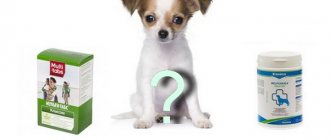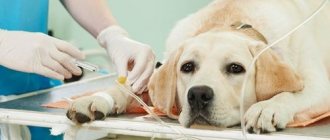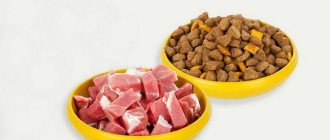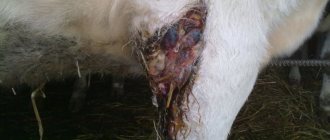A dog that has no health problems is always in a cheerful mood and has a good appetite. An adult animal needs to be fed up to 2 times a day; puppies and young dogs require more frequent feeding. In the case when your four-legged friend refuses to eat once, there is no need to panic, since one missed feeding is not critical. But if the animal refuses to eat for more than 1.5 or 2 days, the owner should sound the alarm, because perhaps his pet is seriously ill.
Reasons for a dog's refusal to eat
An animal can refuse food in many cases, both completely harmless and threatening the dog’s death. The owner must carefully observe his four-legged friend and, in case of serious signs of illness, show the animal to a veterinarian.
There are the following causes of loss of appetite in dogs:
- Changing the usual food . Some animals react very sharply to changes in diet. In the case when the dog owner purchased a different brand of food instead of the one his pet was accustomed to, the animal may refuse to eat the new food. A dog on a natural diet may also not want to eat his dinner if any new ingredient has been added to the food.
- Frequent snacking . It is not recommended to feed the animal between meals, especially when the dog gets tasty morsels from the owner's table. In this case, she can easily refuse to eat her food.
- Feeding poor quality food . Food that is too salty or sour is unlikely to be eaten by your pet, so you need to check the quality of the food every time before giving it to your dog.
- Oral diseases . The pain felt from a broken tooth, infections of the palate, and gums are serious reasons for refusing to eat.
- Infectious and viral diseases . Almost all diseases caused by pathogenic microorganisms lead to loss of appetite. A serious reason to contact a veterinarian is not only a complete loss of appetite, but also other symptoms (fever, pain, vomiting, diarrhea, discharge from the eyes, nose, etc.).
- Signs of poisoning . Food or chemical intoxication can be very dangerous to your pet's health. Signs of poisoning are: refusal to eat, vomiting with foam, bile, diarrhea, lethargy, weakness.
- Diseases of the kidneys, stomach and intestines . Acute renal failure, pyelonephritis, duodenal ulcer, stomach ulcer, intestinal obstruction - not only cause loss of appetite in the dog, but also seriously threaten the life of the four-legged friend.
- The presence of parasites in the body . Worm diseases have a detrimental effect on your pet's health. A sick dog, in addition to lack of appetite, also exhibits other symptoms (increase in the size of the abdominal cavity, nausea, vomiting, diarrhea, constipation, pallor of the mucous membranes).
Some animals have high emotional sensitivity and may refuse to eat when depressed, sad, or sexually active. Often, separation (even short-term) from the owner is the main reason that a dog stops eating. During sexual desire, animals, especially males, often do not eat for a long time. In this case, you should not worry about the health of your pet; as soon as the sexual desire subsides, the dog will regain its excellent appetite.
If there are serious symptoms of various diseases, you should not expect the animal to recover on its own and under no circumstances should you force feed it. The best option would be to call a veterinarian at home, so the dog will be less exposed to stressful situations.
A picky dog refuses to eat: what to do?
Who among us has not met dog breeders complaining about their pets being too picky about food? Or maybe you yourself are knocked off your feet, looking in pet stores and food markets for a delicacy that Their Majesty will finally deign to eat? If the animal is healthy and such behavior is the norm for it, please accept our condolences - you belong to the many thousands of owners of picky dogs.
People whose dogs are capricious and refuse regular dog food can be divided into two groups: those who are satisfied with this state of affairs, and those who would be happy to change something, but do not understand how to do it.
Contrary to popular belief, there are no breeds that are inherently picky eaters. Of course, decorative dogs, such as Chihuahuas, Yorkshire terriers, lap dogs, etc., are more sensitive to roughage than representatives of herd breeds. But it’s one thing to feed such dogs with specialized elite food, and quite another to pamper them with sweets and other unhealthy foods.
Attention! Do not confuse the dog’s whims and refusal of food due to illness or, for example, pregnancy. If the dog usually eats well what is given to it, and the loss of appetite is currently accompanied by depression, fever, vomiting, and indigestion, do not read this article and urgently seek professional veterinary help.
Very often, those who overindulge their dogs with tasty treats themselves love to eat. They “feel sorry” for the dog who “so badly wants” a piece of a bun, fried chicken or smoked sausage. Although in reality they are simply projecting their own love of food onto the animal. Some are even proud of their pet’s pickiness, happily “complaining” about it to their friends: such people think that the dog’s selectivity in food speaks of its “high breed” and good wealth in the family. The funniest thing (or the saddest thing, depending on how you look at it) is that over time, the dogs of such owners actually become so picky that they even refuse “delicacies”: they are sure - and not without reason - that if they refuse what they gave, they will certainly give something different and tastier.
An excellent example of deliberately indulging a dog's whims was given by James Herriot, an English veterinarian and author of a number of books about animals. Remember Mrs Pumphrey and her pug Tricky from the storybook All Creatures Great and Small? A rich widow fed her beloved dog until he began to have health problems: he “lay motionless, breathing heavily, and tears flowed from his eyes.” Harriot quickly “cure” Tricky by replacing biscuits, chicken breast and pies with normal dog food and outdoor play. True, for this he had to take him away from his owner for a while - the veterinarian knew that Mrs. Pumphrey would not have the willpower to “withstand” her pet’s diet.
Only one thing can be said here: ladies and gentlemen, direct your love and “pity” for your pet in a constructive direction! Imagine that he gets sick and he won’t be able to eat all that harmful “human” food that now forms the basis of his diet. What if it is your fault that a healthy dog develops obesity, allergies, liver and kidney problems? Decide already whose weakness you are actually indulging – the dog’s or your own?
There is another category of dog breeders who make their pets picky. They get scared that the dog is sick every time he turns his nose up at the bowl. But, firstly, in rare cases, a dog may starve because its body has a need for it. Secondly, it is very simple to distinguish a picky dog that manipulates its owner from a dog that does not want to eat due to illness: a sick dog, most likely, will not eat either its usual food or gourmet treats.
Now let's move on to people who sincerely believe that it is impossible to change the habits of a finicky, capricious dog. You can - and quite simply and quickly! To do this, you will need a supply of “normal” dog food and a fair amount of willpower.
Unlike people, a healthy animal is not able to starve itself to death. Can you imagine a wolf who refuses beef because he likes donuts with cheese? Likewise, a dog, even the most pampered one, will sooner or later become so hungry that it will eat anything. And don’t worry that she won’t eat anything for a while: fasting is actually good for her. In the wild, predators are not well-fed every day, and this does not prevent them from remaining strong and energetic.
So, give your dog a small portion of normal dog food (if you don't know or have already forgotten how to feed your dog properly, consult your breeder or veterinarian). Be prepared for the fact that you will have to throw out 1-2 servings (which is why it is better not to add too much at once). And now the hardest part: after your pet sniffs the bowl with displeasure and looks at you expectantly...DO NOT GIVE HIM ANYTHING ELSE! If you haven’t eaten it after 10 minutes, put the bowl in the refrigerator. After some time, he will start asking for food - take out what he didn’t eat and offer him again. If you haven’t had time to strongly “corrupt” your dog in terms of nutrition, it will most likely start eating what you’ve given, by the evening at the latest. In particularly advanced cases, the “battle of tempers” can drag on for several days. You will definitely win it if you show restraint and common sense. Ultimately, by teaching your dog not to be picky, you are doing a good deed by saving your pet from possible health problems in the future. Of course, getting your dog to eat is half the battle; it is important to be able to not return to your previous patterns of behavior in relation to its feeding regime in the future. Remember, it is the owner who decides what the dog eats, not the dog!
What to do if your dog has no appetite
If the reluctance to eat is not associated with infectious, viral, helminthic diseases, or serious poisoning, you can help the animal yourself. In any other cases, self-diagnosis and treatment is dangerous; the animal must be entrusted to a veterinarian.
You can improve your appetite in the following ways:
- Skip feeding. For 24 hours, do not offer the dog absolutely any food (especially treats from the table). Clean and fresh water must be freely available. In most cases, one skipped meal is enough to restore your previous appetite.
- Diversify your dog's diet. Introduce more healthy foods into the animal’s food (fermented milk, offal, fresh vegetables, fish), since an unbalanced diet can cause refusal to eat food.
- Reduce food portions. If the dog leaves food in the bowl, the portion of food may be too large and the animal is simply not able to eat it.
- Monotonous food. Feeding your pet only rice or buckwheat may cause reluctance to eat. By diversifying the diet with other cereals, meat and vegetables, it is quite possible to restore the animal’s appetite in the shortest possible time.
- Increase the duration of walking and the intensity of physical activity. Usually, after long and active walks, the dog greedily pounces on the food offered to it.
- If there are obvious signs of poisoning (when the animal is not in serious condition), the stomach is washed with baking soda or a solution (weak) of potassium permanganate and activated carbon is given at the rate of 1 tablet per 10 kg of pet’s weight. In severe cases of poisoning, the dog is immediately taken to the veterinarian.
Check how much food your dog eats per day
This sounds strange, but when tested, it may turn out that the dog has become picky only because it is overfed. This applies more to small breeds. Small dogs require very little food.
However, the owner can often feed his cutie with various dog delicacies throughout the day. Therefore, there is simply no room left in the dog’s stomach to accommodate a portion of breakfast or dinner.
First of all, you need to check how much food your pet actually eats during the day. Note which treats you give your dog just for fun or as a reward, whether on a walk or in the kitchen. Maybe the dog is begging you for food while you are sitting at the table and encouraging such bad behavior from the bottom of your heart.
So it turns out that when it’s time to feed, the pet simply turns away from his bowl and leaves. Because I'm already full!
When to see a doctor
An animal can go without food for quite a long time. As a rule, 1 or 2 days of fasting does not have a detrimental effect on the health of the pet, but if the dog refuses food for more than 2 days, loss of appetite is accompanied by other signs, the alarm should be sounded - the animal is sick.
Immediate assistance from a veterinarian is required if loss of appetite occurs with the following symptoms:
- feverish conditions;
- diarrhea (with mucus, blood);
- pallor, yellowing of the mucous membranes;
- purulent discharge from the nose, eyes;
- vomiting with blood, bile, foam;
- unsteadiness of gait, convulsive conditions;
- severe pain in the animal's body;
- constant lying of the dog on one side;
- disturbance of the urination process (increased, decreased or complete cessation of urination);
- refusal of water.
Some owners, on the advice of their friends or relatives, begin to self-medicate the animal and make fatal mistakes. One of the most common tips for a quick recovery for a pet is to pour vodka into the dog’s mouth. This should not be done under any circumstances, because an alcohol-containing liquid will not cure a sick dog, but will cause a burn to the mucous membrane of the esophagus and stomach.
A dog that has no health problems will have an excellent appetite. In cases where an animal is bothered by something and refuses any food or even treats, immediate action must be taken. Treating your pet yourself using medications intended for humans, as well as traditional medicine recipes, is strictly prohibited. A sick friend must be shown to a veterinarian, who, based on the diagnosis, will select an effective treatment for the animal and return the dog to a good appetite.










